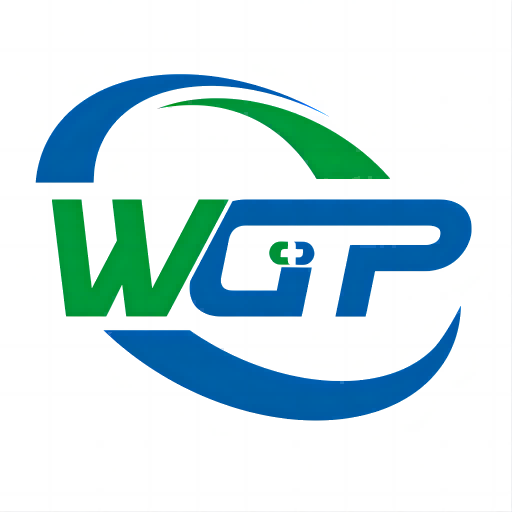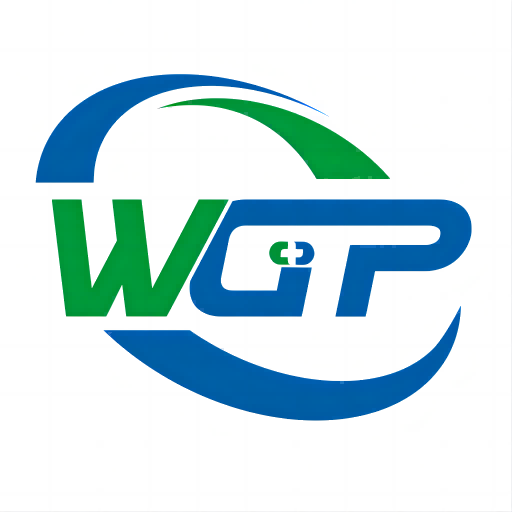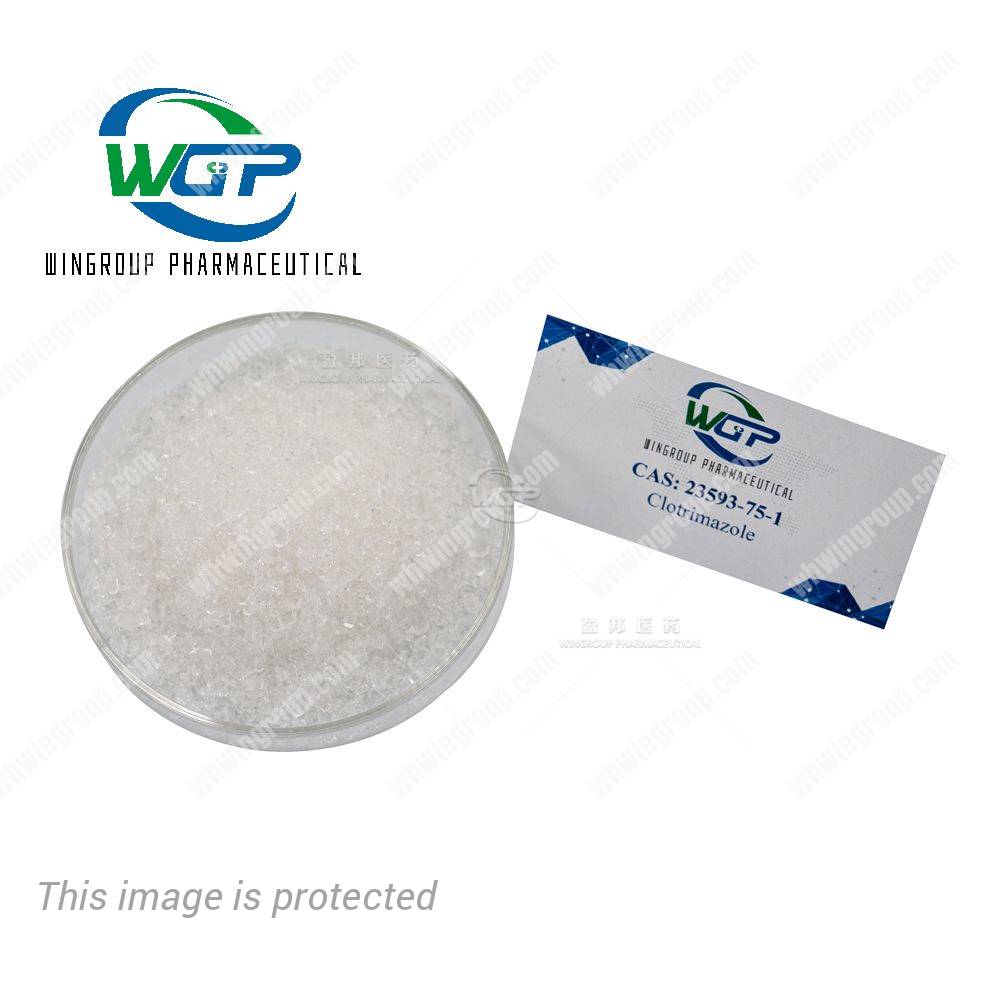- Description
- Our Policy
- Additional information
Description
Clotrimazole CAS 23593-75-1 Product Information
| Product Name: | Clotrimazole |
| Synonyms: | component of Otomax;Empecid;FB 5097;fb5097;Gyne lotrimin;Imidazole, 1-(o-chloro-alpha,alpha-diphenylbenzyl)-;Methane, bis-phenyl-(2-chlorophenyl)-1-imidazolyl-;Mono-baycuten |
| CAS NO: | 23593-75-1 |
| Molecular Weight: | 344.837 |
| Molecular Formula: | C22H17ClN2 |
| Boiling Point: | 482.3±40.0 °C at 760 mmHg |
| Melting point: | 147-149ºC |
| Density: | 1.1±0.1 g/cm3 |
| Appearance: | White to Almost white crystalline powder |
| Applications: | An antifungal compound and CYP inhibitor. Clotrimazole (Lotrimin, Mycelex, etc.) is a synthetic imidazole agent. It acts by altering cell membrane permeability. It inhibits the growth of most dermatophyte species, yeast and Malassezia furfur. |
| Solubility: | Soluble in chloroform, DMSO, DMF and alcohols |
| Storage: | 2-8°C |
clotrimazole cream uses
Clotrimazole cream is an antifungal medication that is commonly used to treat various fungal infections of the skin. It belongs to the imidazole class of antifungal drugs and works by inhibiting the growth of fungi.
Here are some common uses of clotrimazole cream:
- Athlete’s foot (Tinea pedis): This is a fungal infection that affects the feet, causing itching, redness, and flaking of the skin between the toes and on the soles.
- Jock itch (Tinea cruris): It is a fungal infection that typically affects the groin area, causing a red, itchy rash.
- Ringworm (Tinea corporis): Ringworm is a skin infection characterized by circular or ring-shaped patches with red edges and a clear center. Clotrimazole cream can help alleviate the symptoms and treat the infection.
- Candidiasis: Clotrimazole cream can also be used to treat yeast infections caused by Candida species, such as vaginal yeast infections (vulvovaginal candidiasis) and yeast diaper rash in infants.
When using clotrimazole cream, it is important to follow the instructions provided by your healthcare professional or the product packaging. Apply a thin layer of the cream to the affected area and gently rub it in. It is typically applied 2-3 times a day for a specified duration, which can vary depending on the specific condition being treated.
butenafine hydrochloride vs clotrimazole
Butenafine hydrochloride and clotrimazole are both antifungal medications used to treat various fungal infections of the skin. While they have a similar purpose, there are differences in their mechanisms of action and specific uses.
Butenafine hydrochloride:
- Butenafine is an antifungal medication that belongs to the allylamine class of drugs.
- It works by inhibiting the synthesis of ergosterol, a key component of fungal cell membranes, which leads to the disruption of fungal growth and ultimately kills the fungus.
- Butenafine is commonly used to treat athlete’s foot (Tinea pedis), jock itch (Tinea cruris), and ringworm (Tinea corporis).
Clotrimazole:
- Clotrimazole is an antifungal agent that belongs to the imidazole class of drugs.
- It works by interfering with the synthesis of ergosterol, which disrupts the integrity of the fungal cell membrane and results in the death of the fungus.
- Clotrimazole is used to treat a variety of fungal infections, including athlete’s foot, jock itch, ringworm, vaginal yeast infections (vulvovaginal candidiasis), and yeast diaper rash.
Both butenafine hydrochloride and clotrimazole are available in various formulations, including creams, sprays, and powders, for topical application to the affected areas of the skin. The choice between the two medications may depend on factors such as the specific type and severity of the fungal infection, individual response to treatment, and personal preferences.
clotrimazole and betamethasone dipropionate cream
Clotrimazole and betamethasone topical combination is used to treat fungus infections. Clotrimazole works by killing the fungus or preventing its growth. Betamethasone, a corticosteroid (cortisone-like medicine or steroid), is used to help relieve redness, swelling, itching, and other discomfort of fungus infections.
miconazole vs clotrimazole
The key difference between clotrimazole and miconazole is that clotrimazole usually shows a slow response against dermatophytosis and a faster response against candidiasis, whereas miconazole shows an accelerated response against dermatophytosis and a slow response against candidiasis.
tolnaftate vs clotrimazole
Clotrimazole cream treatment is more effective than tolnaftate for uncomplicated otomycosis.
| Transit time | You will normally receive your parcel within 7-15 working days after shipment (this may be delayed in special circumstances, such as Chinese New Year). |
| Receiving method | Generally we will send the goods by courier or special line, of course, if the goods themselves in the local warehouse have goods, also support self-pickup, depending on the circumstances. |
| Overseas warehouse | We have overseas warehouses in some European countries and Australia, such as Germany, Russia and Australia. |
| Delivery Method | WGP will ship via courier companies such as DHL, FedEx, UPS, TNT or EMS. |
| About After Sales | Within 7 days of your receipt of the goods if you find any problems with the goods (broken packaging, less hair, etc.) please feel free to contact our sales, we will help you deal with it in time. |
Additional information
| Weight | 1 kg |
|---|---|
| Melting Point | 147-149°C |
| Boiling point | 482.3±40.0 °C at 760 mmHg |
| Flash Point | 245.5±27.3 °C |
| Density | 1.1±0.1 g/cm3 |
| Solubility | Soluble in chloroform, DMSO, DMF and alcohols,insoluble in water |
| Color | White |
| Form | Powder |










Reviews
There are no reviews yet.